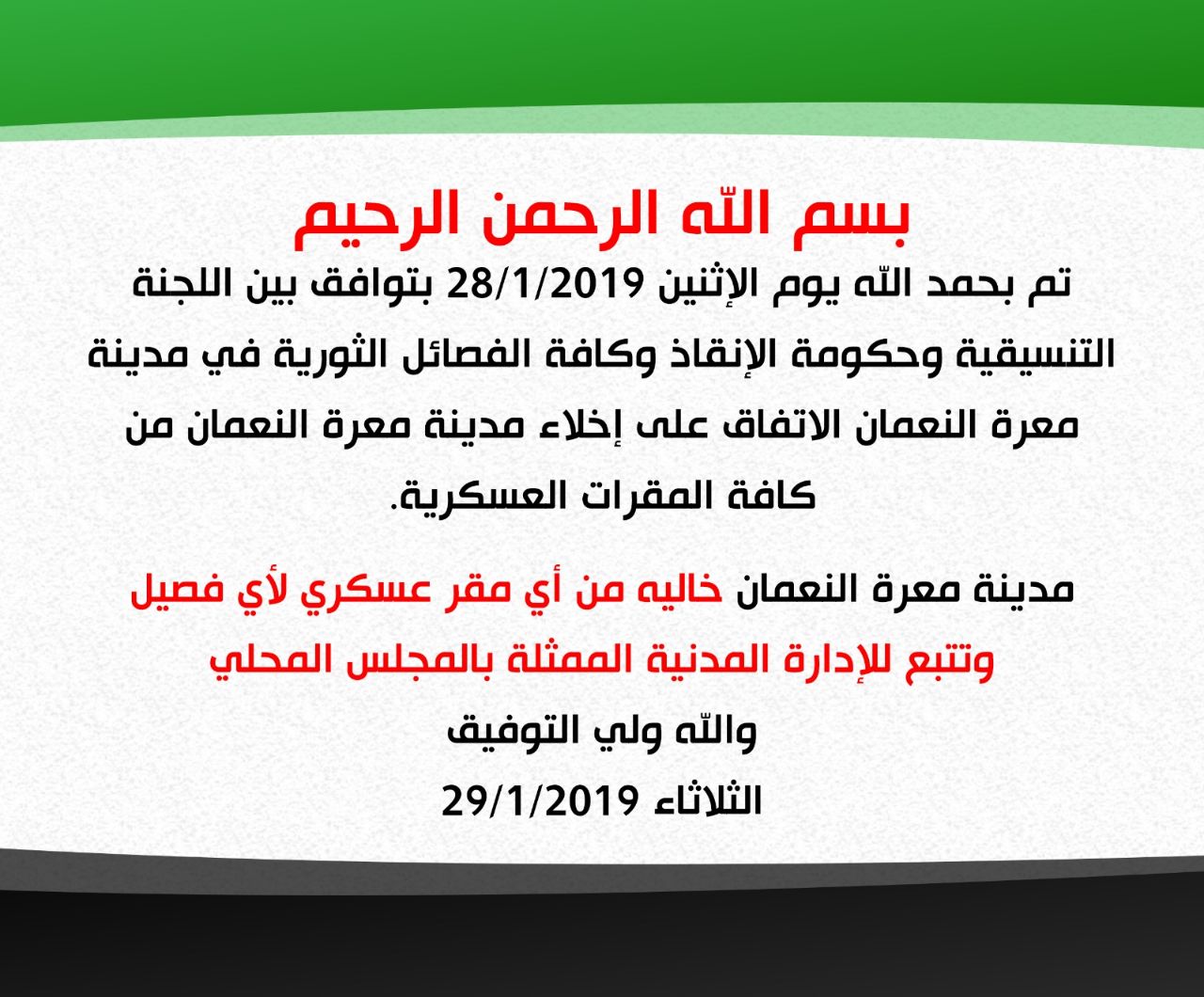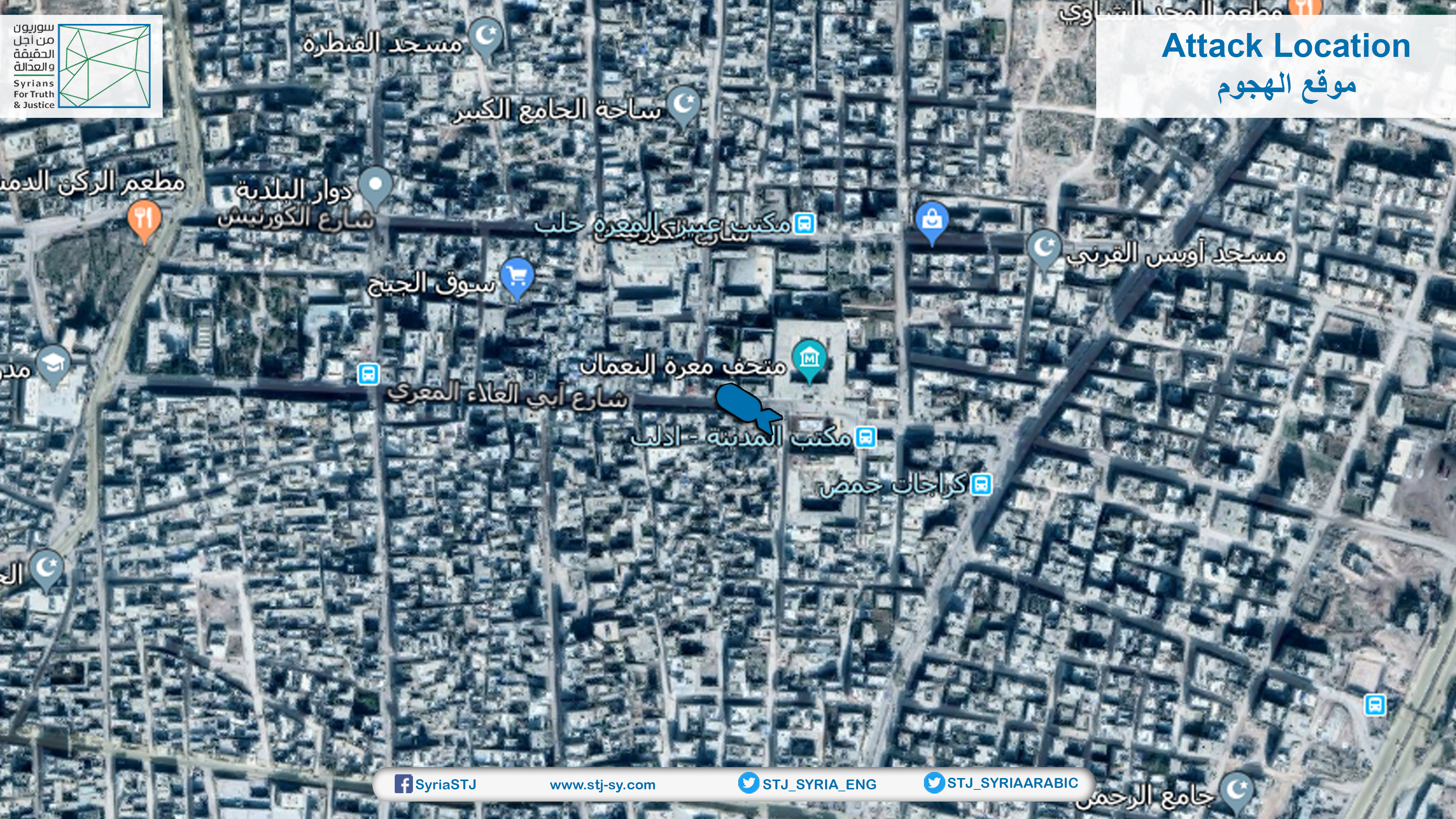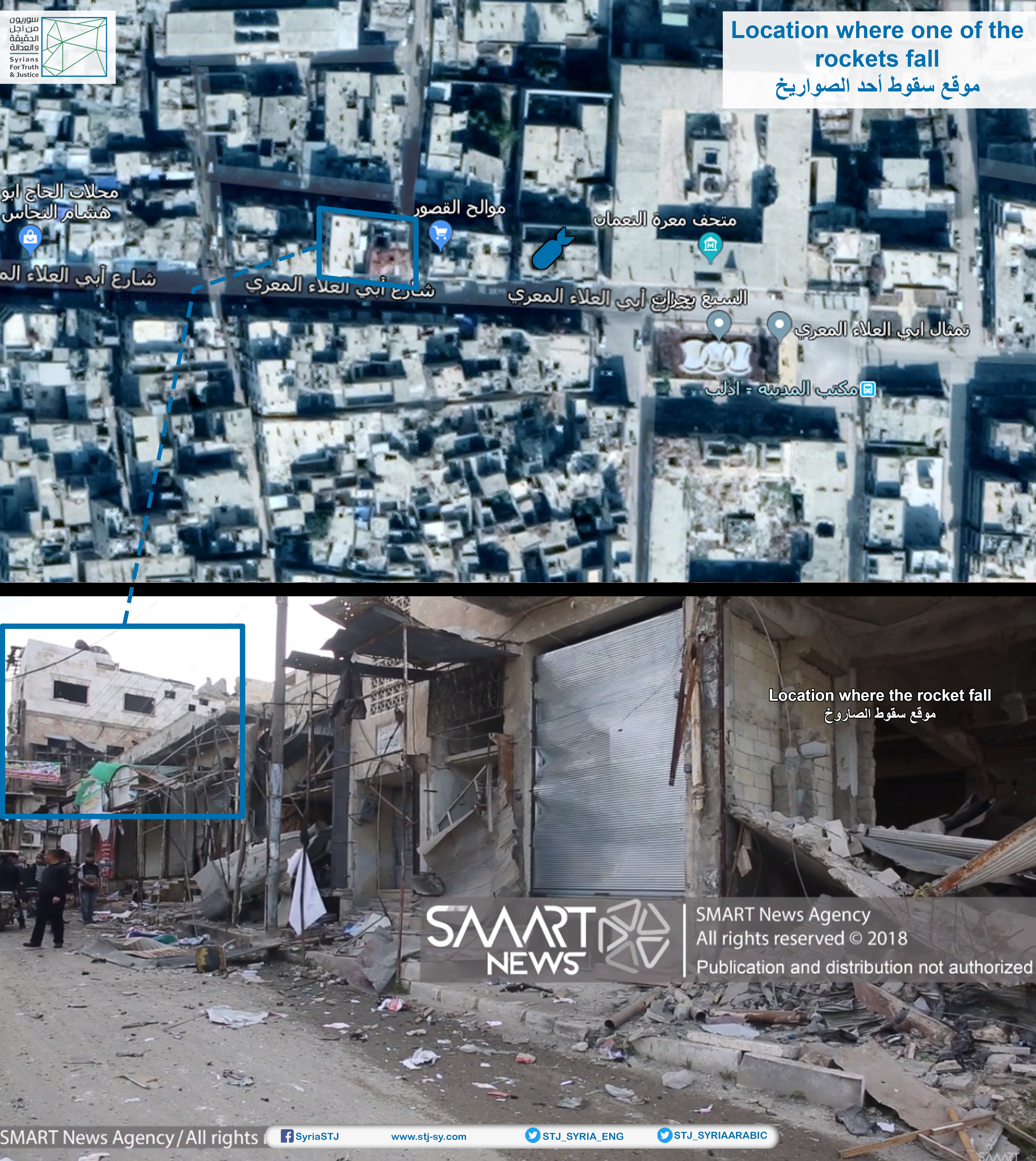In southern rural Idlib and northern rural Hama[1], several regions witnessed a rising tempo of the Syrian regular forces and their Russian ally’s shelling in January 2019, for the regions have endured almost daily shelling that on numerous cases targeted civilian areas, leading to the death of no less than 22 persons, women and children included, and the injury of about 65 others.
The shelling that targeted the city of Maarrat al-Nu’man, Idlib, is, however, considered the most violent, where the toll rose to 11 dead civilians and 35 injured others.
On the other side, armed opposition groups bombarded several Syrian regular forces-held posts in Hama, responding to the latter’s violation of the de-escalation deal, according to testimonies obtained by Syrians for Truth and Justice/STJ.
- Shelling of Southern Rural Idlib:
STJ’s field researchers monitored attacks on no less than 16 towns and cities, which have been targeted with artillery, missile and aerial shelling by the Syrian regular forces and the Russian forces in January 2019. The top attacks took place as thus:
1- Missile and Artillery Shelling Launched by Syrian Regular Forces’ Checkpoints:
On January 29, 2019, the city of Ma‘arrat al-Nu‘man was a target to a missile shelling, reportedly the most violent this month, for it hit several of the city’s neighborhoods and resulted in the death of 11 civilians, including women and children, and the injury of no less than 35 others.
STJ’s field researcher in the city reported on its conditions and happenings prior to the shelling:
“In January 2019, the city was a scene to numerous incidents, triggered by the confrontations between HTS[2] and a number of the armed groups under the National Front for Liberation, where the military bodies and civilian renowned figures agreed to neutralize the city and evacuate the armed groups and military headquarters. On the evening of January 28, 2019, HTS stormed the city and tried to take over the Suqour al-Sham/ Sham Falcons Brigades’ headquarters. Back then, an extensive shooting took place, after which, a deal to demilitarize the city was concluded, less than 12 hours prior to the shelling. The city was supposed to be entirely and immediately demilitarized, but this did not materialize, for elements of HTS and other armed opposition groups remained in the city. The next day, at 1:30 pm, the Syrian regular forces started to bombard the city with artillery weapons. The shelling first targeted the northern neighborhood, then the al-Corniche street and the surrounding of the al-Kabir/Great Mosque, to end at 2:10 pm of the same day.”

Copy of the demilitarization deal of the city of Maarrat al-Nu’man, Idlib, concluded prior to its shelling. Photo credit: Maarrat al-Nu’man Local Council (Facebook/Telegram).
Analysis of the visual evidence of the attack on January 29, 2019:

Image of the city of Maarrat al-Nu’man, showing the bombarded street.

Photo showing the destruction and the location of the residential buildings targeted by the shelling.
On January 28, 2019, the town of Kafr Nabl also was a target to shelling, which caused the injury of several civilians. On the 26th of the same month, the town of Sukayk endured artillery shelling. On the 24th, the town of al-Tah was hit by high-explosive warheads; on the same day the towns of Sukayk, Khuwayn, al-Zarzour and Tell Mannas were targeted by artillery shelling that caused the death of a civilian and the injury of several others in the town of Tell Mannas.
On the 21st day of the same month, the towns of Bidama, Najiyeh, Maraand and al-Tah were attacked by missiles and artillery shells, and on the 20th day, the al-Tah was a target to an artillery shelling. On January the 11th, the town of Jarjanaz was hit by high-explosive missiles, while the two towns of Qatra and Hraki were a target to artillery bombardment.
Concerning the nature of the regions targeted within these towns, Mohammad Karkass, a local activist and a member of the al-Maarra Media Office, informed STJ of the following:
“The bombarded regions are generally civilian areas, residential neighborhoods and agricultural lands. It is worth mentioning that a few of the military posts of the armed opposition groups are located in the vicinity of the targeted areas or near them, but the shelling did not focus on the posts, for the shells and the missiles landed in civilian regions.”
2- Shelling by Russian Aircraft
On January 20, 2019, Russian warplanes conducted an aerial raid, deploying thermobaric/vacuum missiles in their attack on the village of Khan al-Sabil, near the city of Saraqib, which hit an automatic bakery rendering many civilians injured. On the same day, they attacked the village of Kasraya, killing a man and a woman.
On the 4th day of the same month, aircraft, also Russian, launched a raid on a farm to the west of the city of Khan Shaykhun; the bombardment caused the death of seven people from the same family, who have been displaced from the village of Jubbayn, Hama.
Commenting on these raids, the local activist Mohammad Karkass, said:
“We have contacted the civil and military observatories in southern Idlib; they assured us, through handheld radios, that military aircraft took off from the military Khmeimim Air Base only a few minutes before these raids. The observatories did not monitor the taking off of any military aircraft from other air bases.”
II. Cross Shelling between Syrian Regular Forces and Armed Opposition Groups:
Several of rural Hama’s villages were a target to almost daily artillery and missile shelling on the part of the Syrian regular forces, which caused the death of four children, two women and two civilian men, in addition to the injury of no less than 15 other civilians, including children and women. The shelling is a violation of the de-escalation deal, in response to which, the armed opposition groups bombarded a number of areas controlled by the Syrian regular forces. One of these attacks resulted in the injury of a civilian woman.
1- Shelling by Syrian Regular Forces:
The Hama Media Office, run by local activists in northern rural Hama, recorded artillery and missile barrages against no less than 10 towns, on top of which are the following attacks which resulted in a number of civilian casualties.
On January 28, 2019, a child died in the missile shelling of the village of al-Zakah, while a woman died affected by her wounds due to a previous attack on the same village. On the 26th of the same month, a civilian young man died in a heavy machine gun attack on the village of al-Zakah. On the 24th, several persons were injured in the artillery shelling of the al-Lataminah; on the 23rd, the injury of a number of civilians was recorded in an attack on the village of al-Huwayz. On the 22nd, Fatima al-Rahal, a little girl, died and a number of civilians were injured in a missile attack on the town of Kafr Zita. On the 18th, a woman died and other civilians were injured as tank shells rained down the city of Murak, while a young man died in the shelling of the city of the al-Lataminah on the 17th day. Several civilians were rendered injured in a missile attack on the town of Kafr Zita on the 16th day. A Russian drone targeted the city al-Lataminah, due to which a child died and a woman got injured on the 11th day.
Commenting on the various incidents, the local activist Mohammad Hwaish told STJ the following:
“The cities and towns of northern rural Hama have, in general, been a target to near-daily shelling, which focuses on three principal regions; Murak, al-Lataminah, and Kafr Zita. The reason for this is that they are considered the first row of the front with the Syrian regular forces and the staging area of the armed opposition groups. The majority of these regions’ population has been displaced, and they are today home to a staggering 10% of civilians. The Syrian regular forces are intensifying the shelling at this stage since Astana Talks are closing in, a thing they resort to prior to all political talks.”
2- Armed Opposition Groups’ Shelling of Syrian Regular Forces-held Posts
Several armed opposition groups, including Jaysh al-Izza/Army of Glory and Hayat Tahrir al-Sham/HTS, declared targeting posts under the control of the Syrian regular forces in rural Hama, answering the latter’s violation of the de-escalation deal. STJ’s field researchers monitored a few of these attacks, one of which caused the injury of a civilian woman in the town of Mahardah on January 22, 2019.
STJ’s field researcher interviewed a female eyewitness, who said the following:
“Numerous missiles landed on the outskirts of the northern quarter of the town, due to which a woman was injured and rushed to the Mahardah National Hospital. Missiles often end up there, for there is a military post about 3km away from this part, which makes it a frequent target. Missiles hit [this area] every time.”
Another female witness informed STJ’s field researcher of the following:
“Most of the missiles deployed in shelling us end in the vicinity of the town and agricultural lands.”
[1] The shelling attacks undertaken by the Syrian regular forces, the armed opposition groups and the Hayat Tahrir al-Sham/HTS are all considered a violation of the de-escalation deal and that of the demilitarized zone, concluded after the Astana Talks and the Sochi summit, under the auspice of Russia, Turkey and Iran in 2017 and 2018. The de-escalation deal provided for the establishment of Russian and Turkish observation posts as to police the ceasefire between the armed opposition factions and the Syrian government. These disengagement posts were spread in the control areas of both sides in western rural Aleppo and the surrounding of Idlib province, as far as northern rural Hama. For its part, the demilitarized zone’s deal provided for the removal of the heavy weapons of the Free Army and the rest of the armed groups from a 15-20km deep area. It is worth mentioning that HTS declared its refusal of the Astana deal, while it made no direct statements concerning the demilitarized zone’s deal.
[2] “Hay’at Tahrir al-Sham Fully Controls Idlib and Rural Regions in Aleppo and Hama”, Syrians for Truth and Justice, January 22, 2019, last visit: February 19, 2019. https://stj-sy.org/ar/view/1155.

